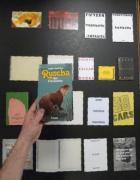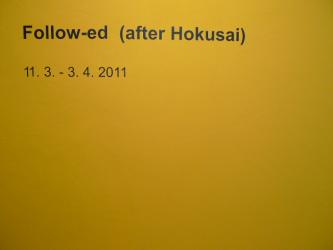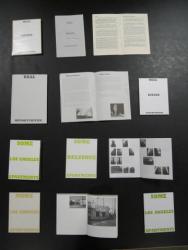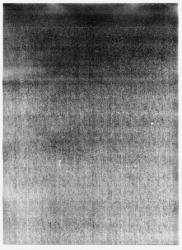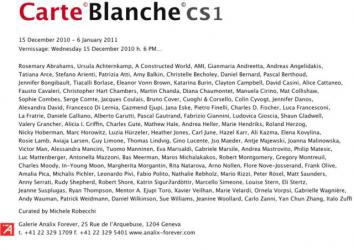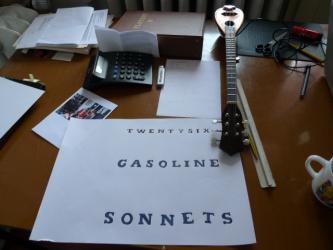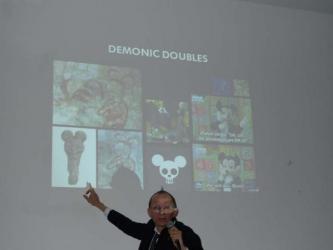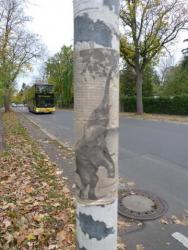news
Ruscha der Fischotter aka: Printed Matter And Other Visible Things On Paper Not Necessarily Meant To Be Viewed As After Ruscha aka: One Hundred Views Of One Hundred Views Of Mount Fuji, If Someone Says So aka: SIX HANDS AND A CHEESE SANDWICH is a book about books, a catalogue and an art/bookwork in its own right.
follow-ed (after hokusai) is an exhibition curated by Michalis Pichler and Tom Sowden, featuring conceptual artworks, which for the most part use photography, the book form, and are somewhat ruschaish. click here to see installation views --- By now the appropriation and paraphrasing of Ed Ruscha constitutes a genre of its own.
with: Dianne Arndt, Eugènia Balcells, Jean-François Bergez, Bureau d’investigation photographique, Mel Bochner, Stanley Brouwn, Ian Burn, John Byrum, Philippe, Clerc, Roy Colmer, A constructed world, Continuous Project, Andrew Dadson, Eric Doeringer, Patrick Dubrac, FF FW, Judith Fleishman, Michael Gibbs, Sharon, Gilbert, Marie-Ange Guilleminot, Yoko Gunji, Thomas Hirschhorn, Janet Janet, Ben Kinmont, Sean Landers, David Lasnier, Lefevre Jean Claude, Sol Lewitt, Sara Mackillop, Stéphane Magnin, Ross Martin, Jonathan Monk, Antoine Moreau, Jean-Luc Moulène, Patrick Mullins, Louise Odes Neaderland, Richard Olson, Blaise Parmentier, Michalis Pichler, David Renault, Jean-François Robic, Barbara Rosenthal, Dieter Roth, Temporary Services, Mathieu Tremblin, Ben Vautier, Larry Walczak, Eric Watier.
Custom having once given the name of " the ancients " to our pre-Christian ancestors, we will not throw it up against them that, in comparison with us experienced people, they ought properly to be called children, but will rather continue to honor them as our good old fathers. M.S.
programme vernissage / opening 17/12/2010 de 15h à 22h projections Centre Pompidou, Paris
ouverture 18-19/12/2010
Forum -1 de 11h à 20h
installations
performances
Printed Matter presents the fifth annual NY Art Book Fair, November 5–7 at MoMA PS1, Long Island City, Queens. Free and open to the public, the Fair hosts over 250 international presses, booksellers, antiquarian dealers, artists and publishers from twentyfour countries, offering the best in contemporary art book publishing.
FOREVER & TODAY, INC. PRESENTS FEATURING A READING, SLIDE SHOW, MUSICAL Organized by Ingrid Chu and Savannah Gorton Forever & Today, Inc. presents Berlin-based poet and conceptual artist Michalis Pichler for an event hosted by the Goethe-Institut New York at its Wyoming Building location. The evening features a reading, with a slide show and musical performance, and the U.S. launch of his book, Der Einzige und sein Eigentum (The Ego and Its Own), 2009, published by Pichler's Berlin imprint "greatest hits". The launch also includes Forever & Today, Inc.'s newly commissioned limited edition Chinese translation book cover and glossary.
MICHALIS PICHLER AT THE GOETHE-INSTITUT
NEW YORK WYOMING BUILDING
PERFORMANCE, AND NEW BOOK/EDITION LAUNCH
Tuesday, November 2, 2010, 7-9pm
Hosted by Goethe-Institut New York; Program in English
Goethe-Institut Wyoming Building, 5 East 3rd Street; FREE
Subway: B/D/F/M to Broadway-Lafayette; 6 to Bleecker
Sonntag, 24. Oktober 2010, 11.00 Uhr Im Rahmen des Symposiums soll kontrovers durchleuchtet werden, wie aktuell im Kunstbetrieb und in einer digital geprägten Gesellschaft mit der Ressource „Wissen“ umgegangen wird. Wie bildet sich Wissen, und welche mehr oder weniger offene Form von Zugang zum Wissen sollte es geben? Welche Möglichkeiten der autonomen Wissensbildung hat heute ein Künstler, und welche Form von Individualität oder Gemeinschaft kann so geschaffen werden? Wie funktioniert eine Performance als Drehscheibe für künstlerische Autonomie und Wissensklau?
Muffatwerk
Eintritt frei
Hildegard Karnath, born on October 22nd 1910, worked as a designer for most of her life, designing movie posters for the UFA in the 30ies. In private, for more than six decades she was clipping images from magazines and assembled a vast collection of images (animals, celebrities, flowers - dozens of themes).
She passed away recently, her archive was sold on the fleamarket, and probably most material has been lost.
At what would have been her 100th birthday, one of her collections was pasted in her neighbourhood, where she used to live for half a century.
